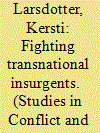|
|
|
Sort Order |
|
|
|
Items / Page
|
|
|
|
|
|
|
| Srl | Item |
| 1 |
ID:
134988


|
|
|
|
|
| Summary/Abstract |
Illegal organizations, like mafia syndicates, gangs, and insurgencies, are often highly cohesive and hostile toward the outside world. Such groups cultivate a particular form of “anti-social” capital, which relies on ingroup bonding and limits outgroup bridging for the purpose of commissioning illicit acts. We argue that experiences within the group leave members with varying intensities of anti-social capital, and that higher intensities lead to significantly weaker relationships with political institutions and civil society, even many years after they exit the group. We test this theory using survey data from 1,485 former members of insurgent and paramilitary groups in Colombia, along with insights from 68 qualitative interviews. We find strong evidence that anti-social capital has individually varying and sticky effects on former members. These effects are pervasive and intense, and exhibit surprising and counterintuitive properties: former members of pro-state militia with higher levels of anti-social capital are systematically less likely to trust political institutions, while members of peasant-based insurgent groups with high levels of anti-social capital are less likely to participate in their communities.
|
|
|
|
|
|
|
|
|
|
|
|
|
|
|
|
| 2 |
ID:
134989


|
|
|
|
|
| Summary/Abstract |
Transnational insurgents are a common feature of contemporary wars, but research on how to address this problem is still scarce. This article examines the South African Defence Force's (SADF) counterinsurgency against Namibian transnational insurgents. It concludes that the South African forces focused a large amount of their efforts outside the borders of Namibia. Highly coercive operations in Angola and Zambia created the space for hearts and minds activities in Namibia, as well as forcing neighboring states to end their support for the insurgents. Although the war in Namibia is somewhat different from contemporary wars, SADF's cross-border strategy gives us some important insights into the regional dynamics of civil wars.
|
|
|
|
|
|
|
|
|
|
|
|
|
|
|
|
| 3 |
ID:
134987


|
|
|
|
|
| Summary/Abstract |
Terrorist groups are not completely isolated, socially “free-floating” entities, but emerge from and operate within a specific, immediate social environment—what we call the radical milieu—which shares their perspective and objectives, approves of certain forms of violence, and (at least to a certain extent) supports the violent group morally and logistically. In this article we introduce an approach to conceptualize and analyze this formative and supportive social environment of clandestine groups, addressing the questions of how the radical milieu emerges, what forms it takes, and what role it plays in shaping the development of violent groups. Our focus, thereby, rests on relationship-patterns between violent groups and radical milieus as well as on processes of interaction between radical milieus and their broader political and societal environment, which may entail dynamics of support and control but also isolation and radicalization
|
|
|
|
|
|
|
|
|
|
|
|
|
|
|
|
| 4 |
ID:
134990


|
|
|
|
|
| Summary/Abstract |
This article uses a collective-action framework to study the mobilization of the Arrow Boys (AB), a community defense militia in South Sudan. Drawing on general collective-action explanations, this article argues that the mobilization of the AB was facilitated by two factors: (1) a strong overlap of the fighter's private and the community's public benefit and (2) close social relationships and expectations within the community. The article supports these theoretical claims by, first, examining the scope conditions under which the AB formed and, second, drawing on individual interviews with AB members from Western Equatoria in South Sudan.
|
|
|
|
|
|
|
|
|
|
|
|
|
|
|
|
|
|
|
|
|